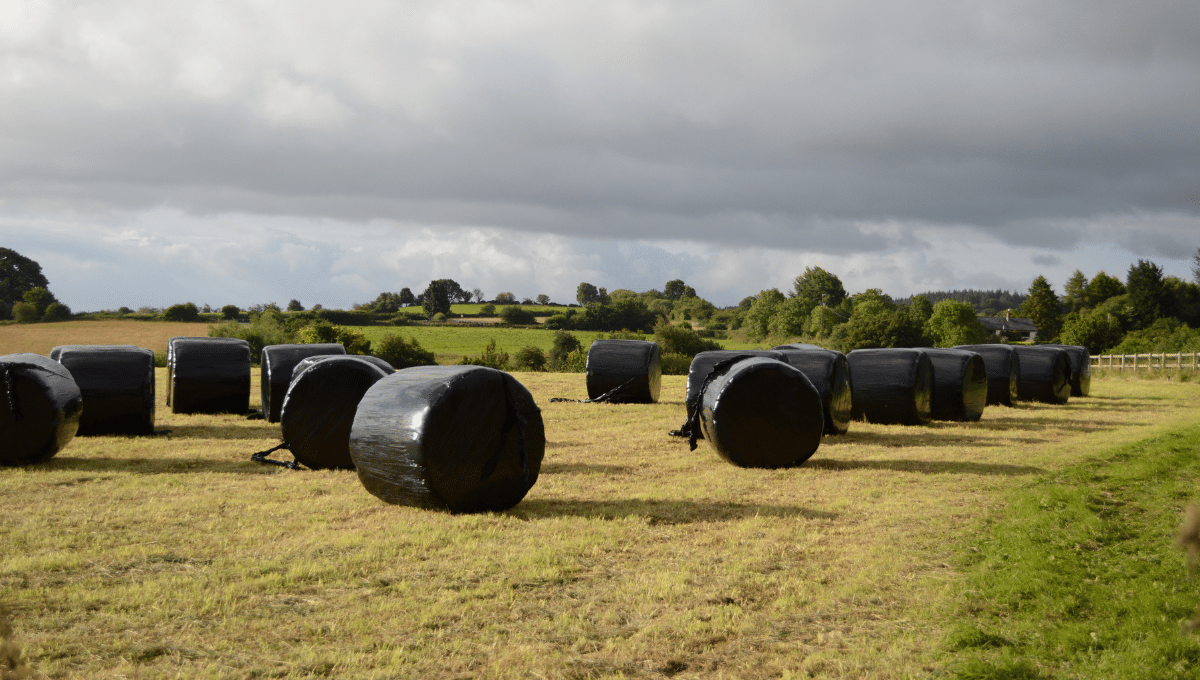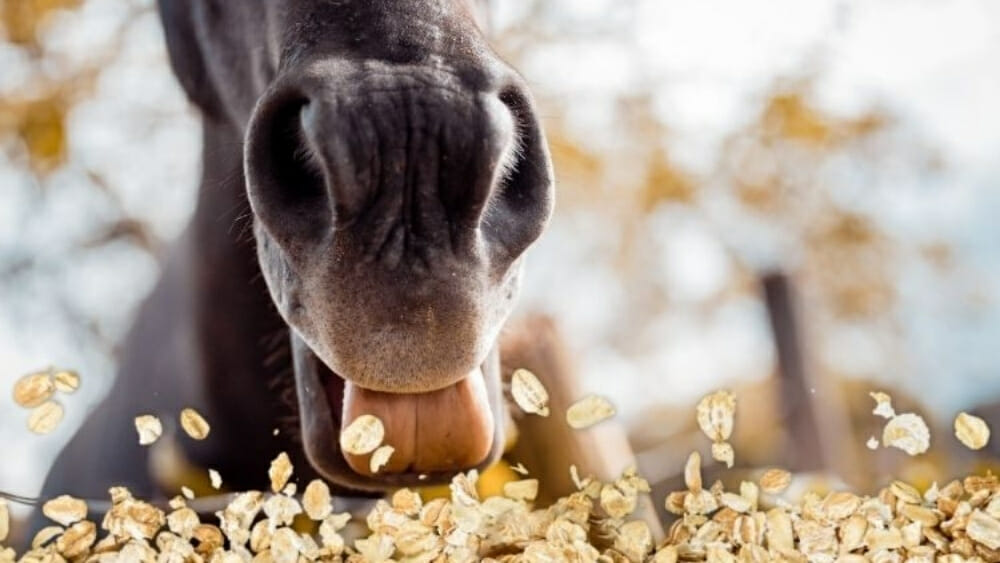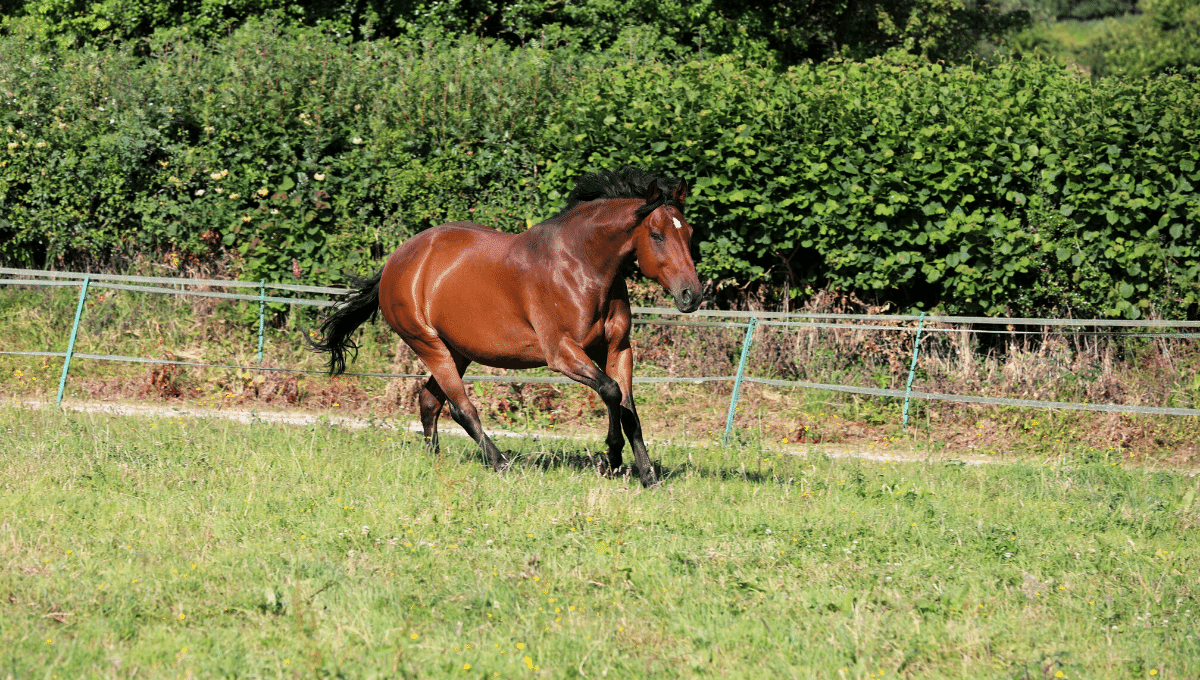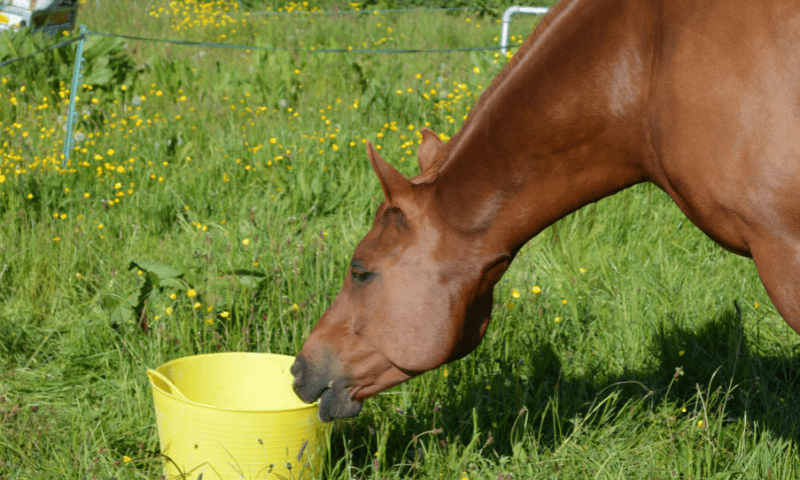Forageplus understands the need to feed good quality haylage to horses but how do you know if it’s any good?
Here we discuss what horse haylage is. How this feed for horses is made and how you can tell whether it is good for your horse.
What is horse haylage?
Haylage is the grass that has been preserved by ensiling it, this means wrapping it in an anaerobic environment. A grass crop intended for this can be cut slightly earlier than hay and can be made anytime from early June right through to September.
How is horse haylage made?
How to make haylage. The grass is cut in the same way as for horse hay but horse haylage is dried for less time which is a benefit here in the UK with our very fickle weather. Usually, the drying time is around 3 days but can be shorter if the weather has been very dry and because the grass is dried for less time the water content of haylage is higher than that of hay.
Typically at Forageplus, we like to see haylage at 70 – 80% dry matter. The grass is baled in small or large bales and wrapped tightly to exclude oxygen.
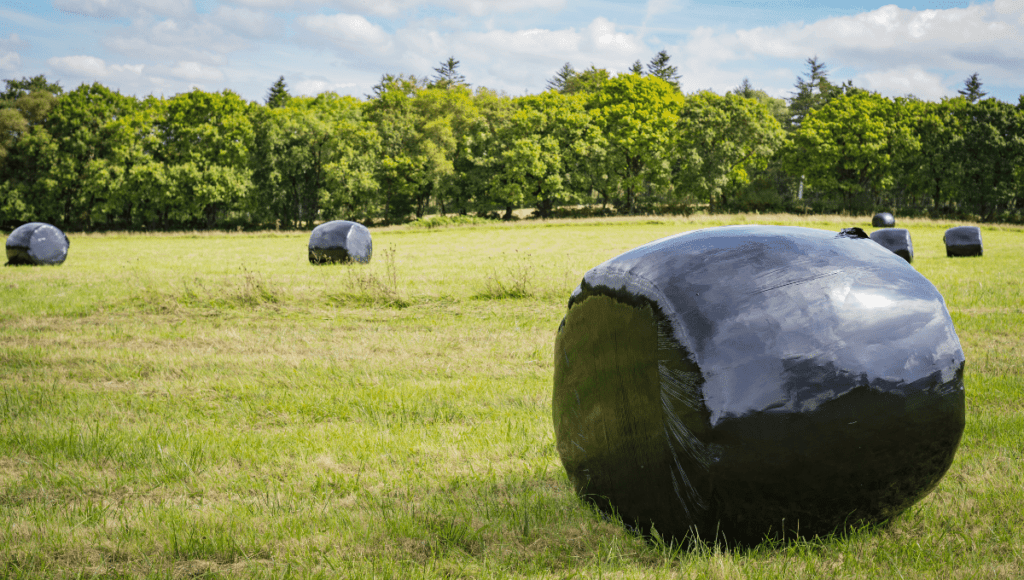
How long does horse haylage last?
The drier horse haylage is the longer it will last once opened. Typically we find that the haylage we make, when at 80% dry matter, will last just over a week once opened during summer. In winter our horse haylage will last up to 3 weeks.
Once baled the grass starts to ferment and pickle. This process results in increased acidity. The pH should drop to around 5.0. This creates an environment where moulds and fungi cannot grow.
At the end of the fermentation process, you should have a stable forage that keeps for at least a year as long as the bag or wrapping remains fully intact. This pickling process can take 8-10 weeks.
What does a haylage bale look like on the outside?
The outside wrapper should be in good condition, not punctured or ripped and not overly faded. You can check this by peeling a bit of the wrap back and seeing if it is a different colour underneath. If it is faded, it suggests the bale has spent a long time in the sun and the wrap may have started to go porous and let oxygen in.
There should be plenty of layers of wrap. The plastic used for wrapping bales is not 100% airtight. Each layer of wrap reduces the porosity by about 50%. So 6 layers of wrap will let half as much air in as 4 layers, and 8 layers will let half as much in again. We suggest using at least 8 layers for the best protection and sealing.
There should also be no visible tears or ‘repairs’ to the bale. Haylage patches or tape, as long as it has been applied in the dry, not allowed moisture in and has created an airtight seal will seal the bale up again if it has been punctured, but you should inspect the patch and if in doubt not accept the bale. Never accept a bale where the wrap has been damaged unless it was damaged very recently.
Ideally, the bales should be covered with netting or a haylage cover to protect the bales from being punctured by birds. Small holes which puncture the wrap from birds landing on the bales or pecking them are likely to be the biggest reason for bales being damaged and then becoming unsuitable to feed to horses.
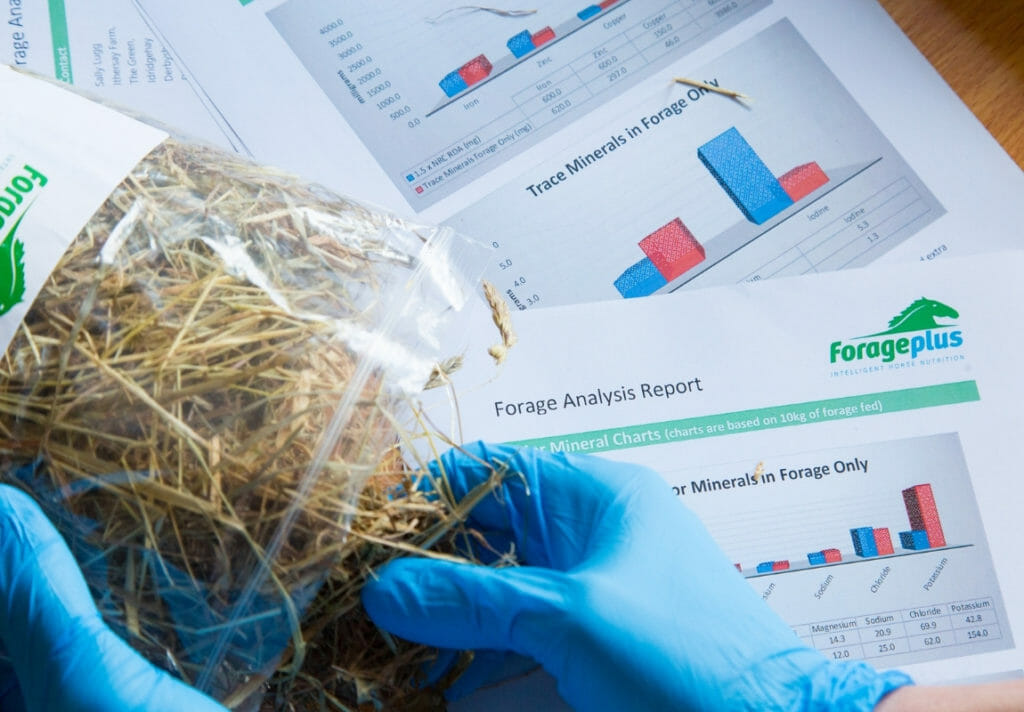
What should good horse haylage inside the bale look like?
- It should be a bright golden colour and look like a damper version of hay. We have found that horses prefer haylage which is more like hay.
- It Should be soft and clean to the touch and perhaps slightly sticky although we prefer haylage that is less sticky and more soft and dry.
- When you first unwrap it, it should feel warm, the same temperature as a nice warm summer day.
What should good horse haylage smell like?
- It should smell like a summer’s day.
What does bad horse haylage look like?
- It is a dark brown or very dark colour indicating excessive heating causing the forage to caramelise. This reduces the digestibility of the protein even though the horses may eat it up.
- There are lots of dark brown leaves and stems. This can mean that dead material was incorporated into the crop. This can be left over from a previous crop or could be a result of the crop being over-mature when harvested. As long as the rest of the matter looks and smells ok, this is generally not a problem apart from the visual impact.
- Another reason for the presence of dark leaves is that these are herbs such as plantains and other beneficial plants. The dark colour is because these types of plants are full of antioxidants. In this situation the presence of these dark leaves is beneficial.
- There are moulds or other growth on the haylage. This will indicate that there was insufficient lactic acid produced to preserve it, or that the wrap has been damaged. Where the wrap is intact it is possible the haylage was too dry when wrapped or that there are not sufficient soluble sugars in the grass to complete fermentation. In these cases, the pH level will not fall low enough to prevent the growth of undesirable moulds and fungi.
- If coloured moulds are growing on it. These coloured moulds can be very dangerous and they should never be fed to horses.
- White spots that do not smell may be yeast. Yeast may grow slowly on haylage that has high levels of sugar in it. It can also grow where there is a pocket of oxygen or if it was inadequately pressed failing to remove all the oxygen. This is because yeast can grow both aerobically and anaerobically. Generally, yeast is not bad for horses, but frequent occurrences of it on bales would suggest a deeper problem.
What does bad horse haylage smell like?
- If you smell a putrid or rancid smell from the haylage then this is of concern. Putrid smells indicate the presence of butyric acid from Clostridium bacteria and horses should not eat this haylage. This type of problem occurs mainly when haylage has been made too wet. In this situation, there will be insufficient lactic acid produced to preserve, pickle and ferment the haylage.
- Yeasty bread, alcoholic or fruity smells indicate the presence of yeast growth. If you can smell it there is probably too much yeast growth and fermentation will have suffered and the aerobic stability may be poor.
- Vinegar odours suggest an excess of acetic acid. This is the result of a different type of fermentation when there was a lack of lactic acid-producing bacteria. Horses are usually reluctant to eat it if it smells like this.
- Burnt odours indicate excessive heating took place and there was something seriously wrong with the fermentation process that occurred.
What does bad haylage feel like?
- It should not be hot to touch. If it is hot to touch, it is either still going through fermentation or it is aerobically respiring (ie. rotting).
- If it is slimy and wet to the touch, it was baled too wet and probably has not fermented properly. This will go off very quickly and care should be taken when feeding so that horses do not have their digestive systems upset.
What are the problems with horse haylage?
One of the biggest problems with horse haylage is the presence of the clostridium botulinum organism which, as discussed, tends to proliferate in the very wet matter.
Clostridia are bacteria that live in the soil and can contaminate the grass crop due to soil splash or the crop being cut too close to the ground. However, if it is dried to a dry matter above 50% then it will be too dry to support the clostridia to multiple.
Haylage that is very acidic and wet may upset the hindgut of the horse leading to colic or even laminitis.
Is it safe to feed horses haylage?
Some people say that haylage is richer than hay. This is a myth as it is impossible to tell the nutritional value of a forage just by looking at it.
The nutritional value of any forage is determined by the time of year it was cut and the way it was handled after cutting. For example, June cut forages tend to be higher in both protein and sugar than later cuts.
The species of grass or grasses and plants contained within the bale also influence the nutritional content greatly. The main thing to understand is that the only way you can find out the levels of any nutritional portion is to scientifically test a representative sample.
Haylage will be safe and a good feed for horses as long as it is made well and within a certain dry matter range. Haylage with a very low dry matter content will be high in water, this type of haylage is more suitable for feeding to ruminants.
What is the difference between hay and haylage?
The water content is much higher than that of hay so to feed enough dry matter content you always need to feed more haylage than hay. For example, if the hay fed is 85% dry matter and the haylage fed is 70% dry matter then you will need to feed 15% more haylage by weight because there is 15% more water in each kilogram.
How much haylage to feed a horse?
Ideally, you need to carry out forage analysis to check the dry matter content, energy and protein levels of the haylage fed to a horse. The dry matter content will tell you how much water is in the horse haylage. A 500kg horse will need to eat around 10kg of dry matter to maintain weight.
To make the maths simple if the haylage is 70% dry matter then to get 10 kg of dry matter you will need to feed 14.2 kg per day. Compare this with 11.7 kg of horse hay you would feed if the horse hay was 85% dry matter.
To be sure of how much horse haylage to feed it is best to analyse and check the water amount it contains. You can find out lots about testing horse haylage here.
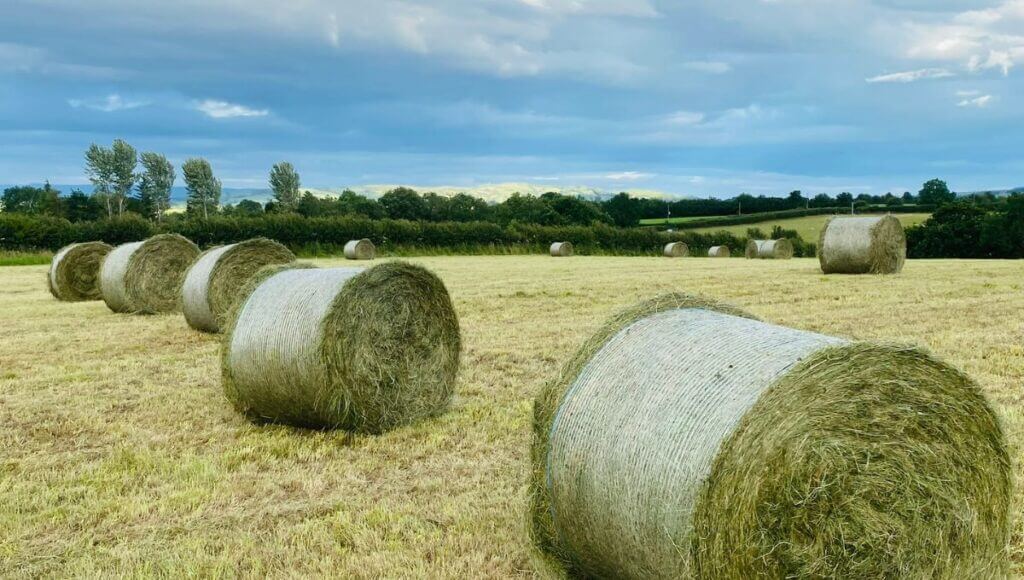
We hope this article is useful to horse owners. Here at Forageplus, we have been making our horse haylage feed for over 15 years. Our horses thrive upon it and it provides an excellent dust-free nutritious source of forage, but it must be made and stored carefully so that it remains a safe forage feed for horses.
We have been very concerned to improve the soil the Forageplus horse haylage is grown upon. We have done this and have careful applications to improve the balance of the minerals available in the soil to the roots of the plants.
We have also carefully maintained our grass meadows to encourage a wide diversity of plant species which enhances the nutritional value of what is fed to our horses. This careful approach coupled with the feeding of minerals and vitamins matched to the forage fed is proving to be the way to create truly healthy horses.
Forageplus offers a range of analysis services to test the quality of your hay, haylage, grass, soil or water. You can view the full range of our analysis services here.
If you don’t want to feed haylage we also stock fully tested hay, below 10% in ESC sugar and starch which is safe for horses and ponies prone to laminitis.
We stock a full range of horse feed balancers that are matched to the most common deficiencies found in forage and horse haylage. You can read more about these here.

